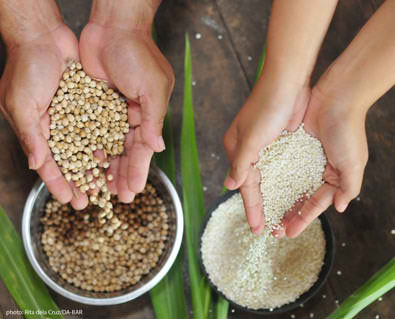Standing tall in the wild, adlay (Coix lacryma-jobi L.) can be easily overlooked due to its grass-like appearance that blends well with the other wild plants. But unlike weeds, the stem of adlay could grow from 1 to 3 meters tall (from 3 to nearly 10 feet). It bears tear-like shape grains which become the source of (staple) food of many indigenous people particularly in the highlands.

Adlay belongs to the family Poaceae or the grasses, the same family to which wheat, corn, and rice belong. It produces good yield in areas where rice and corn hardly grow like the highlands. Adlay can tolerate low pH, poor soil quality, water logging and is resistant to pests.
Adlay as a staple food crop has a good eating quality. Its grains which when matured are harvested, pounded, threshed, and winnowed, can be cooked and served steamed just like rice. As food source, adlay is as versatile as rice. It has a pleasant mild flavor making it a good ingredient in soups and broths. The grain can be ground into flour and used to make breads, pastas, and porridge. Its ground grains can be roasted and turned into coffee or tea and further processed and fermented into wine.
Just like its counterparts, rice and corn, adlay is highly-nutritious. In a chemical analysis provided by Food and Nutrition Research Institute (FNRI), a 100-gram serving of adlay is rich in carbohydrate (73.9 g), protein (12.8 g), and fat (1.0 g). It is also packed with other minerals including calcium (25 mg), phosphorus (43.5 mg), iron (5 mg), niacin (4.3 mg), thiamine (0.28 mg), and riboflavin (0.19 mg).
Given the crop’s potentials, which can complement the long-established major staples such as rice and corn, the Adlay Research and Development (R&D) Program was initiated. The program, which is being led by the Bureau of Agricultural Research (BAR), pushes for the development, utilization, and promotion of adlay as an alternative crop to our food staples, and as an additional source of income and livelihood in non-traditional corn and rice areas.
The bureau has initiated various activities to introduce the crop to the public and hopefully to champion it as a staple crop along rice and corn. Adaptability yield trials were initially conducted in the regions, followed by more trials implemented by DA Regional Field Offices (RFOs), state universities and colleges (SUCs), and now, even the private sector. These yield trials brought about the development of site-specific recommendations for different areas in the country.
With the sufficient supply of adlay seeds to expand its productions, the DA-RFOs have been developing and creating food products from adlay. This is still part of promoting the crop to the public highlighting its versatility as a food ingredient and its nutritive value providing rice-dependent consumers other food source of carbohydrates.
Across the regions, various adlay products have been developed and are now available to be tapped by the private sector for mainstream market. Among these products include: adsoy, gourmix, champorado, 3-in-1 coffee, nutrimeal, herbal coffee mix, breakfast cereal, wine, adlay pop, cracker, cereal bar, and polvoron.
These products were developed through the research initiatives of the R&D partners of the bureau with the hope of not only introducing adlay as a versatile food ingredients but more importantly, bringing these products to the awareness of the public and providing them alternative aside from the usual staple crops that we eat. ### (Rita T. dela Cruz)
———-
For more information about the study, please contact:
Project Monitoring and Evaluation Division
Bureau of Agricultural Research
Phone: (63) (2) 928-8505 local 3110
